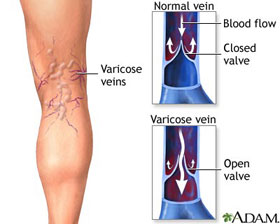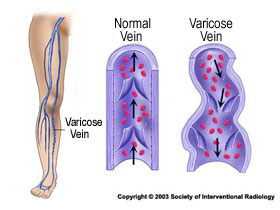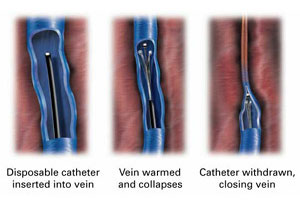What Are Varicose Veins and How Are Varicose Veins Unhealthy?
If you experience bulging leg veins, restless legs,
pain, discomfort, swelling, itching or discoloration in
your legs, you may have varicose veins.
Varicose veins can become enlarged and in some cases
quite prominent. They can be seen in some individuals
are serpiginous, raised lumps in the thigh, legs and
calves.
When they become prominent, they can be seen through the skin and may develop a purple-blue hue. If the skin over the varicose vein ulcerates, occasionally bleeding occurs from the thin walled vein. This can be quite dramatic.
More commonly, however, once the diameter reaches 5 mm, varicose veins cause itching, burning or an ache in the effected leg. This is especially notable when the individual is upright for several hours during the day.
If the condition is left untreated, the skin
overlying the vein hardens (gets indurated) and
hyperpigmentation of the skin sets in. This is followed
by swelling of the lower extremity. The final step in
the pathophysiology of varicose veins is ulceration of
the skin.
Even in these latter stages, there is significant
benefit to be gained by radiofrequency ablation of the
varicose vein or phlebectomy.
How Do You Diagnose And Evaluate Varicose Veins?
 Following
the history and physical examination, the next major
diagnostic step is the ultrasound examination. The
ultrasound examination gives us a real time and detailed
view of your varicose vein system. Next, we prepare a
comprehensive "venous flow map," which
illustrates the path of the blood flowing through the
abnormal veins and where the trouble begins. Special
attention is paid to the perforators and the
saphenofemoral junction for reflux disease.
Following
the history and physical examination, the next major
diagnostic step is the ultrasound examination. The
ultrasound examination gives us a real time and detailed
view of your varicose vein system. Next, we prepare a
comprehensive "venous flow map," which
illustrates the path of the blood flowing through the
abnormal veins and where the trouble begins. Special
attention is paid to the perforators and the
saphenofemoral junction for reflux disease.
Patients are often surprised to see how extensive and complicated their varicose veins are and how superficial they are beneath the skin. This veon map that we create depicts details not visible from surface examination of the skin, that is, details that make treatment more effective.
Since each patient and each patient leg (right and left) are uniquely different, the vein map helps us configure the optimal plan to eliminate abnormal and varicose veins.
How Do You Treat Varicose Veins?
There are several treatment options for varicose
veins available.
- compression stockings
- ultrasound guided VNUS Closure
- minimally invasive vein stripping
- and/or sclerotherpy
The VNUS Closure procedure treats the underlying cause of varicose veins, namely saphenofemoral reflux disease (commonly known as venous reflux disease).
What Can I Do To Prevent Varicose Veins?
Many of the things that seem to cause varicose veins are difficult to avoid such as a family history or a sedentary way of life.
Whenever possible, avoid standing for prolonged periods of time. Walking is much better for the veins and helps blood return to the heart more efficiently, preventing the pooling of blood in the legs.
In professions or occupations that require extended periods of standing, a few steps should be taken at regular short intervals to help the venous circulation. These include things like wearing support stockings. No supplements or drugs are effective in preventing the formation of varicose veins.
What About Elevating The Lower Extremities?
If you are sitting, leg elevation at or near the
level of the heart can significantly alleviate symptoms
of leg pain and swelling.
Other things that you can do include:
|
|
Home | About us | Philosophy | Orthotics service | Prosthetics service |
Innovative Technology | Photo Galleries | Video Galleries| Contact us | Inquiry | Branch|Collections|
|



















